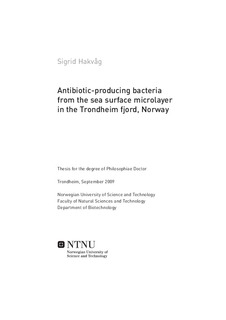| dc.contributor.author | Hakvåg, Sigrid | nb_NO |
| dc.date.accessioned | 2014-12-19T13:14:18Z | |
| dc.date.available | 2014-12-19T13:14:18Z | |
| dc.date.created | 2009-12-10 | nb_NO |
| dc.date.issued | 2009 | nb_NO |
| dc.identifier | 299597 | nb_NO |
| dc.identifier.isbn | 978-82-471-1730-9 (printed ver.) | nb_NO |
| dc.identifier.isbn | 978-82-471-1731-6 (electronic ver.) | nb_NO |
| dc.identifier.uri | http://hdl.handle.net/11250/245626 | |
| dc.description.abstract | The marine environment has so far been poorly utilized in the search for (producers of) novel antimicrobial compounds. Marine bioprospecting might therefore be a promising field of research for the pharmaceutical industry as an alternative to terrestrial sources and synthetic production of pharmaceuticals.
In this project, over 4000 cultivable isolates have been isolated from different locations in the Trondheim fjord and along the coast of Trøndelag, Norway. Over 1000 of these bacteria were isolated from the sea surface microlayer, whereas the rest originated from sediment samples. The diversity of the isolates from the sea surface microlayer have been investigated by studying cultivable bacteria from two sampling locations as ‘model-samples’. Whole-cell based antimicrobial assays revealed surprisingly high numbers of isolates displaying antagonistic activity among the assayed streptomycetes. 16S rDNA analyses indicated that several isolates seemed to be closely related, and studies on the PKS type I genes present in these samples revealed that recent horizontal gene transfer might have taken place. The results indicate that de-replication of isolates can not be performed based on 16S rDNA sequences alone, and the identification of unique KS-sequences in some of these isolates further supports this statement. Two streptomycete isolates from the sea surface microlayer displayed activity against a vancomycin-resistant Enterococcus sp. Analysis of the bacterial extracts indicated that this might be due to the production of a novel antibacterial compound.
Plasmids play an important role in the horizontal gene transfer among bacterial species. The genes involved in the biosynthesis of the antifungal polyene macrolide candicidin were found to be present on a linear plasmid in one on the isolated strains. Production of candicidin was found to be widely distributed among Streptomyces bacteria isolated from the Trondheim fjord, and it is thought that the plasmid might be involved in spreading the gene cluster in the marine environment.
A Gram-negative strain in the isolate collection showing antibacterial activity was show to be a new strain of the genus Collimonas. The Collimonas CT (Coast ofTrøndelag) produces the blue pigmented compound violacein, and genome scanning identified genes for biosynthesis of this compound, as well as several other gene clusters for the production of secondary metabolites of potential industrial interest. | nb_NO |
| dc.language | eng | nb_NO |
| dc.publisher | Norges teknisk-naturvitenskapelige universitet, Fakultet for naturvitenskap og teknologi, Institutt for bioteknologi | nb_NO |
| dc.relation.ispartofseries | Doktoravhandlinger ved NTNU, 1503-8181; 2009:168 | nb_NO |
| dc.title | Antibiotic-producing bacteria from the sea surface microlayer in the Trondheim fjord, Norway | nb_NO |
| dc.type | Doctoral thesis | nb_NO |
| dc.contributor.department | Norges teknisk-naturvitenskapelige universitet, Fakultet for naturvitenskap og teknologi, Institutt for bioteknologi | nb_NO |
| dc.description.degree | PhD i bioteknologi | nb_NO |
| dc.description.degree | PhD in Biotechnology | en_GB |

